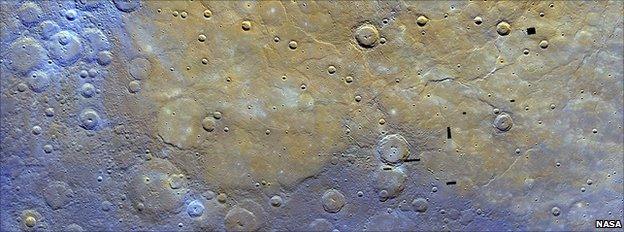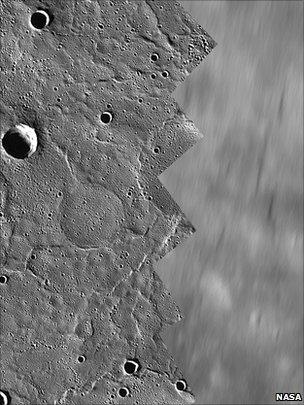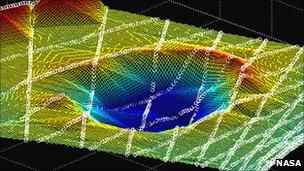Messenger spies Mercury in detail
- Published

An enhanced colour view shows the smoother northern volcanic plains on Mercury to have a different composition (yellow) to the surrounding material
The US space agency's (Nasa) Messenger spacecraft is starting to open up a whole new vista on the planet Mercury.
The probe went into orbit around the inner-most world in March, and has been relaying a stream of data ever since.
Its latest pictures from just a few hundred kilometres above the surface are expected to provide important new clues to the origin of the planet and its geological history.
Nasa believes much of what we thought about Mercury will need to be revised.
"We had many ideas about Mercury that were incomplete and ill-formed that came out of our three flybys with Messenger and the flybys in the 1970s by the first spacecraft to visit Mercury, Mariner 10," said Messenger principal investigator Sean Solomon of the Carnegie Institution of Washington, US.
"Many of those ideas are having to be cast aside as we see orbital data for the first time. We are confirming a few theories but many others are being cast into the dustbin of science."
Messenger has now returned more than 20,000 pictures, a great many at resolutions that finally allow scientists to begin a proper interpretation of surface features.
This is particularly true of the polar regions, where previous imagery was poor or even absent.
At the north pole, Messenger can discern a huge expanse of smooth plains some four million square kilometres in area - about half the size of the continental USA.
"From our more detailed look at this beautiful large unit of smooth plains, we're seeing all kinds of evidence for volcanism and tectonic deformation," explained Brett Denevi, a mission scientist from Johns Hopkins University Applied Physics Laboratory. "You can see 'ghost craters' that were impact craters that were later covered over by lava."
Messenger went to Mercury to prove or disprove a number of cherished theories.
One concerned a 20-year-old hypothesis, supported by radar observations from Earth, that suggested some polar craters might hide reserves of water-ice.
On the face of it this seems an extraordinary proposition given that surface temperatures on Mercury, certainly at the equator, can exceed 400C - hot enough to melt lead.

Comparison: Messenger is now producing much sharper views of polar regions than during the flybys
But without a thick atmosphere to trap heat, it is possible that permanently shadowed regions could stay cold enough to preserve ices for millions, if not billions, of years.
Messenger has begun testing this theory by deploying a laser altimeter to map the shape of craters at the poles - with some encouraging results. Already it has found a depression that is deep enough and dark enough to have the right conditions.
"Stay tuned," said Dr Solomon. "This is a very exciting hypothesis that has stayed with us for 20 years, and it has passed its first test with flying colours.
"We look forward to results from our geochemical remote-sensing instruments - the neutron spectrometer, in particular - which will demonstrate whether or not the material at the poles is likely to be water-ice on the basis of excess hydrogen."
Messenger's X-Ray Spectrometer (XRS) has been investigating the presence and abundance of different atomic elements in surface materials, and has established rapidly that the rocks have a distinct signature that sets Mercury apart from its planetary neighbours.
"What's clear here is that Mercury is not the Moon and it's not the Earth," explained Larry Nittler, also of the Carnegie Institution.
"The surface of Mercury occupies a fairly unique location on the diagram for the surfaces of terrestrial planets. It's got lower aluminium and more magnesium relative to silicon, so it has a lower abundance of feldspar [minerals], and so it has clearly undergone a unique geological history."

A laser altimeter on Messenger is mapping the shape of craters in the planet's polar regions
XRS observations also reveal significant quantities of sulphur - at least a factor of 10 times higher than is seen at Earth. Why that should be is not clear, but probably points to the fact that Mercury formed in a different part of the Solar System to Earth where the raw materials for planet growth had a different composition.
Another new discovery concerns Mercury's magnetic field. The planet, along with Earth, is alone among the terrestrial planets in having a global magnetic field.
The probe has now identified a north-south asymmetry in this field which will allow far more charged particles streaming off the Sun to strike its south pole than its north.
These impacts are what lift atoms off the surface - sputtering, as scientists call it - to create Mercury's super-tenuous atmosphere (more properly described as an exosphere). The impacts also change the colour, reflectance and chemistry of the surface over time.
"What we thought on the basis of our flybys was that Mercury's magnetic field was a miniature version of Earth's magnetic field, produced by similar processes and with broadly similar geometry," said Dr Solomon. "Now we are in orbit, we can measure that magnetic field every day, and what we are seeing is that it is not a miniature of the Earth's field."
- Published18 March 2011
- Published15 July 2010